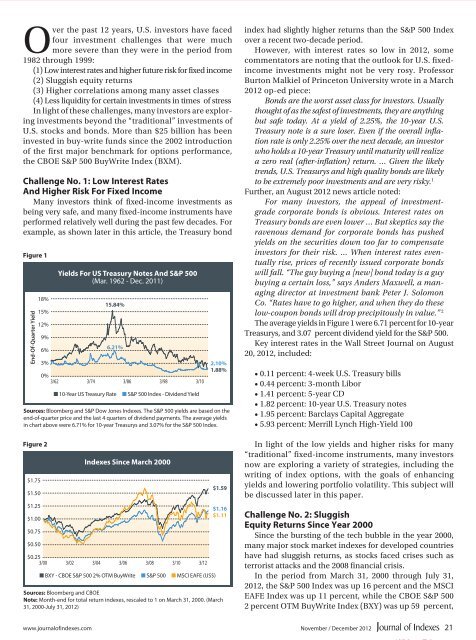Download complete issue - IndexUniverse.com
Download complete issue - IndexUniverse.com
Download complete issue - IndexUniverse.com
Create successful ePaper yourself
Turn your PDF publications into a flip-book with our unique Google optimized e-Paper software.
Over the past 12 years, U.S. investors have faced<br />
four investment challenges that were much<br />
more severe than they were in the period from<br />
1982 through 1999:<br />
(1) Low interest rates and higher future risk for fixed in<strong>com</strong>e<br />
(2) Sluggish equity returns<br />
(3) Higher correlations among many asset classes<br />
(4) Less liquidity for certain investments in times of stress<br />
In light of these challenges, many investors are exploring<br />
investments beyond the “traditional” investments of<br />
U.S. stocks and bonds. More than $25 billion has been<br />
invested in buy-write funds since the 2002 introduction<br />
of the first major benchmark for options performance,<br />
the CBOE S&P 500 BuyWrite Index (BXM).<br />
Challenge No. 1: Low Interest Rates<br />
And Higher Risk For Fixed In<strong>com</strong>e<br />
Many investors think of fixed-in<strong>com</strong>e investments as<br />
being very safe, and many fixed-in<strong>com</strong>e instruments have<br />
performed relatively well during the past few decades. For<br />
example, as shown later in this article, the Treasury bond<br />
Figure 1<br />
End-Of-Quarter Yield<br />
18%<br />
15%<br />
12%<br />
9%<br />
6%<br />
3%<br />
Figure 2<br />
Yields For US Treasury Notes And S&P 500<br />
(Mar. 1962 - Dec. 2011)<br />
15.84%<br />
6.21%<br />
0%<br />
3/62 3/74 3/86 3/98 3/10<br />
■ 10-Year US Treasury Rate<br />
■ S&P 500 Index - Dividend Yield<br />
2.10%<br />
1.88%<br />
Sources: Bloomberg and S&P Dow Jones Indexes. The S&P 500 yields are based on the<br />
end-of-quarter price and the last 4 quarters of dividend payments. The average yields<br />
in chart above were 6.71% for 10-year Treasurys and 3.07% for the S&P 500 Index.<br />
$1.75<br />
$1.50<br />
$1.25<br />
$1.00<br />
$0.75<br />
$0.50<br />
Indexes Since March 2000<br />
$0.25<br />
3/00 3/02 3/04 3/06 3/08 3/10 3/12<br />
■ BXY - CBOE S&P 500 2% OTM BuyWrite ■ S&P 500 ■ MSCI EAFE (US$)<br />
$1.59<br />
$1.16<br />
$1.11<br />
Sources: Bloomberg and CBOE<br />
Note: Month-end for total return indexes, rescaled to 1 on March 31, 2000. (March<br />
31, 2000-July 31, 2012)<br />
www.journalofindexes.<strong>com</strong><br />
index had slightly higher returns than the S&P 500 Index<br />
over a recent two-decade period.<br />
However, with interest rates so low in 2012, some<br />
<strong>com</strong>mentators are noting that the outlook for U.S. fixedin<strong>com</strong>e<br />
investments might not be very rosy. Professor<br />
Burton Malkiel of Princeton University wrote in a March<br />
2012 op-ed piece:<br />
Bonds are the worst asset class for investors. Usually<br />
thought of as the safest of investments, they are anything<br />
but safe today. At a yield of 2.25%, the 10-year U.S.<br />
Treasury note is a sure loser. Even if the overall inflation<br />
rate is only 2.25% over the next decade, an investor<br />
who holds a 10-year Treasury until maturity will realize<br />
a zero real (after-inflation) return. … Given the likely<br />
trends, U.S. Treasurys and high quality bonds are likely<br />
to be extremely poor investments and are very risky. 1<br />
Further, an August 2012 news article noted:<br />
For many investors, the appeal of investmentgrade<br />
corporate bonds is obvious. Interest rates on<br />
Treasury bonds are even lower … But skeptics say the<br />
ravenous demand for corporate bonds has pushed<br />
yields on the securities down too far to <strong>com</strong>pensate<br />
investors for their risk. … When interest rates eventually<br />
rise, prices of recently <strong>issue</strong>d corporate bonds<br />
will fall. “The guy buying a [new] bond today is a guy<br />
buying a certain loss,” says Anders Maxwell, a managing<br />
director at investment bank Peter J. Solomon<br />
Co. “Rates have to go higher, and when they do these<br />
low-coupon bonds will drop precipitously in value.” 2<br />
The average yields in Figure 1 were 6.71 percent for 10-year<br />
Treasurys, and 3.07 percent dividend yield for the S&P 500.<br />
Key interest rates in the Wall Street Journal on August<br />
20, 2012, included:<br />
• 0.11 percent: 4-week U.S. Treasury bills<br />
• 0.44 percent: 3-month Libor<br />
• 1.41 percent: 5-year CD<br />
• 1.82 percent: 10-year U.S. Treasury notes<br />
• 1.95 percent: Barclays Capital Aggregate<br />
• 5.93 percent: Merrill Lynch High-Yield 100<br />
In light of the low yields and higher risks for many<br />
“traditional” fixed-in<strong>com</strong>e instruments, many investors<br />
now are exploring a variety of strategies, including the<br />
writing of index options, with the goals of enhancing<br />
yields and lowering portfolio volatility. This subject will<br />
be discussed later in this paper.<br />
Challenge No. 2: Sluggish<br />
Equity Returns Since Year 2000<br />
Since the bursting of the tech bubble in the year 2000,<br />
many major stock market indexes for developed countries<br />
have had sluggish returns, as stocks faced crises such as<br />
terrorist attacks and the 2008 financial crisis.<br />
In the period from March 31, 2000 through July 31,<br />
2012, the S&P 500 Index was up 16 percent and the MSCI<br />
EAFE Index was up 11 percent, while the CBOE S&P 500<br />
2 percent OTM BuyWrite Index (BXY) was up 59 percent,<br />
November / December 2012 21

















